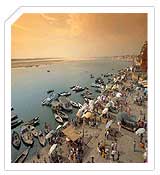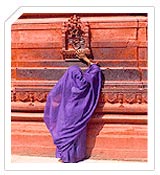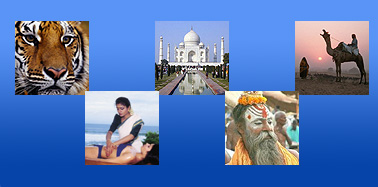|
|
|
|
|
|
|
Home » Indian
Cities » Cities of North India » Varanasi
|
|
|
|
Back
» Varanasi
|
|
|
 Varanasi, sprawling along the left bank of the river Ganga is the holy city of Hindus. With its array of shrines, temples and palaces rising in several tiers from the water's edge, Varanasi is one of the most fascinating cities in the east. It is also a city of fairs and festivals, celebrating about four hundred of them during the year. Since time immemorial, Varanasi has been a centre of learning and the tradition is kept alive today by the Benaras Hindu University founded in 1916. Varanasi, sprawling along the left bank of the river Ganga is the holy city of Hindus. With its array of shrines, temples and palaces rising in several tiers from the water's edge, Varanasi is one of the most fascinating cities in the east. It is also a city of fairs and festivals, celebrating about four hundred of them during the year. Since time immemorial, Varanasi has been a centre of learning and the tradition is kept alive today by the Benaras Hindu University founded in 1916.
Sightseeing at Varanasi -
The Ghats : of Varanasi Ghats are the major attractions of Varanasi. There are about hundred ghats in the city and each of them is marked by a lingam and occupies its own special place in the religious geography of the city. The ghats, though some of them have crumbled over the years, continue to thrive with early-morning bathers, Brahmin priests offering puja and people practicing meditation and yoga. Though most of the ghats are used for bathing, there are several 'burning ghats' were bodies are cremated.
Alamgir Mosque : Also known as Beni Madhav Ka Darera, the Alamgir Mosque is a blend of the Hindu and Mughal styles of the architecture. The mosque, built by Aurangzeb on the site of the Vishnu Temple, overlooks the Panchganga Ghat.
Durga Temple : Located 2 kilometres south of the old city, this eighteenth century Durga Temple is also known as the Monkey Temple due to many aggressive monkeys that reside here. The temple was built in a common north Indian style with an ornate shikhara, consisting of five segments symbolizing the elements and supported by finely carved columns.
 Bharat Mata Temple :
This temple of Bharat Mata (Mother India), inaugurated by Mahatma Gandhi, lies about 3 km west of Godaulia, outside the old city. Here, instead of gods and goddesses, one finds a huge relief map in marble of the whole of Indian subcontinent and Tibetan plateau. The map is said to be perfectly to scale both vertically and horizontally with mountains, rivers and the holy tirthas (pilgrimage centres) all clearly visible. Bharat Mata Temple :
This temple of Bharat Mata (Mother India), inaugurated by Mahatma Gandhi, lies about 3 km west of Godaulia, outside the old city. Here, instead of gods and goddesses, one finds a huge relief map in marble of the whole of Indian subcontinent and Tibetan plateau. The map is said to be perfectly to scale both vertically and horizontally with mountains, rivers and the holy tirthas (pilgrimage centres) all clearly visible.
Tulsi Manas : Temple Built in 1964, the Tulsi Manas Temple stands about 150 m south of Durga Temple. The temple, dedicated to Lord Rama is situated at the place where Tulsidas, the great medieval seer, is believed to have lived and written the great epic "Shri Ramcharitmanas". The two tier walls of the temple are engraved with the verses and scenes from this great epic.
Other attractions are : Emperor Aurangzeb's Mosque, the sacred bull, the well of knowledge Vishwanath Temple, Benaras Hindu University with its marble Shiva temple.
Reaching Varanasi -
Air : Well connected to Delhi, Khauraho, Lucknow, Mumbai by air.
Rail : Ahmedabad, Cochin, Delhi, Gwalior, Kolkata, Madras, Mumbai, Tirupati, Puri are well linked by railways to Varanasi.
Road : Varanasi, on NH 2 from Kolkata to Delhi, and NH 29 to Gorakhpur is well connected to the rest of the country by good motorable roads. Some of the major road distances are : Agra - 565 km, Allahabad - 128 km, Bhopal - 791 km, Bodhgaya - 240 km, Kanpur - 330 km, Khajuraho - 405 km, Lucknow - 286, Patna - 246 km, Sarnath - 10 Km.
|
| |
|
|
|
|


